From the September 2016 issue of GCM magazine:
Team spirit
The grounds staff at Hazeltine National Golf Club, site of this month’s Ryder Cup, epitomizes the spirit of the event. Hint: It’s all about the team.

Photo courtesy of PGA of America
Howard Richman
Read this story in GCM's digital edition »
If “It’s 5 o’clock somewhere,” as Alan Jackson and Jimmy Buffett sing, 720 Pioneer Trail in Chaska, Minn., is as good a place as any.
We’re talking 5 in the morning, though, so grab a cup of coffee and settle in, because this hot spot is percolating with anticipation. Even four-legged Eddie, an aging, black-and-white border collie who patrols the maintenance facility, is up and at ’em, greeting those arriving at this early hour. In time, another one of those finest-hour moments will unfold here.
Welcome to Hazeltine National Golf Club, site of the 41st Ryder Cup. The colossal event that captivates the golf scene worldwide on a biennial basis will go down here Sept. 30 through Oct. 2. You know the format: Team USA vs. Team Europe. One more team, however, deserves a mention: Team Tritabaugh.
GCSAA Class A superintendent Chris Tritabaugh and his crew have been doing their thing, business as usual, with a we’re-on-the-same-page mentality in full force. “We all know what the goal is,” Tritabaugh says. Prepping for events of this magnitude has become almost routine for Hazeltine National, which has been the site of two U.S. Opens, two U.S. Women’s Opens, two PGA Championships, a U.S. Amateur. There’s more, but you get the picture.
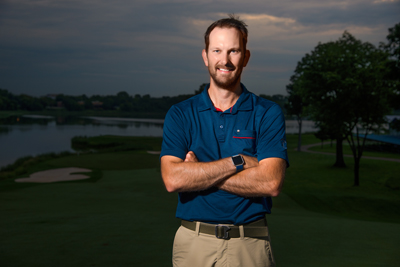
Chris Tritabaugh, the GCSAA Class A superintendent who has overseen Hazeltine National Golf Club since 2013, says he has never prepared for an event quite like the Ryder Cup, which rolls into town this month.
Photo by Kent Withington
Speaking of routine, not a day goes by in the confines of the maintenance facility that assistant superintendent Mike “Red” Graves doesn’t open the door for his co-workers as they exit to start their tasks, sending them on their way with a fist bump and a smile. “It sets the tone for the day, every day,” Graves says. “We’re a team here. What makes us so successful is an ability to collaborate. Everybody is heard. It creates a phenomenal product at the end.”
Hazeltine National and the state of Minnesota are pulling together to pull off this rather significant main event, with statewide organizations such as the Minnesota GCSA and the Minnesota Golf Association (MGA) supporting Hazeltine National’s efforts. In it all, there is a sentiment that perfectly matches the spirit of the Ryder Cup: Team effort means everything. And the team is juiced up for this.
“Play throughout the state is up, and tee sheets already are filling up before and after the Ryder Cup at a time when hunting and fishing usually is on everybody’s mind,” says Tom Ryan, executive director and CEO of the MGA. “We even have local clubs holding Ryder Cup-like events. Everybody is talking about it.”
Tritabaugh, a native of Minnesota, loves the passion. “This is Hazeltine’s and Minnesota’s event,” he says. “Team is what we are all about, all the time.”
Like father, (kind of) like son
This isn’t just another typical son-of-a-superintendent story. Oh, John Tritabaugh was indeed a superintendent for 31 years — just not that type of superintendent. He was a school superintendent in Minnesota, and his career included 14 years in Albany, a small town near the heart of the state, where he and his wife, Laurie, raised their children, Chris, Adam and Emily. The Tritabaugh kids mowed two teachers’ lawns across the street from the family’s home on Meyer Ave. That is, until they landed summer jobs at Albany Golf Club. “So the school superintendent ended up mowing those lawns,” John Tritabaugh says with a laugh.
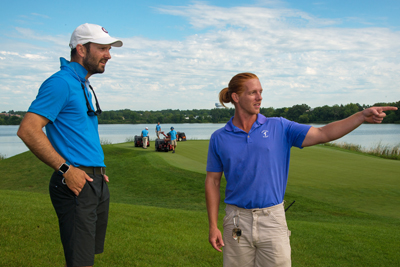
Hazeltine National assistant superintendent Mike Graves
directs Tritabaugh to work being done on the course.
Graves is in his sixth season at the club.
Photo by Kent Withington
Although Chris eventually became a superintendent in a different field, he acquired some of the same values and leadership qualities his father used in his position. “The big similarity with our jobs is that we both work with people,” John says. “You’ve got people you’re in charge of that are there to do a job. What you’d like to do is make sure you surround yourself with good people. For me, it was teachers and principals. Then, you just get out of the way and let them do their jobs. I’m pleased to see that is what Chris has done.”
Chris, a 17-year GCSAA member, says, “I learned a lot from observing my dad in his job. One thing that always amazed me was his complete knowledge of the school operation. He knew what everyone’s role was, and he knew it because he paid attention to them and their job, but that didn’t mean he micromanaged. He would ride the bus routes every fall so if a driver had a problem with their route, he knew why, or maybe was able to help make an adjustment to avoid an issue down the road.”
Chris’s journey in the golf course superintendent profession started with picking up range balls and loading a Cushman with gravel so he could go out and fill potholes on cart paths at Albany GC. “I changed cups right away too. I was horrible at it. I never got the plugs straight,” he says.
Superintendent Tom Kasner showed patience with Tritabaugh, though, who paid close attention to everything Kasner did. “Our staff had fun in those days,” says Tritabaugh, who was superintendent at Northland Country Club in Duluth, Minn., for six years before coming to Hazeltine National in 2013. “We got to be a cohesive unit, sharing stories, laughs and all that comes out of a day working together. You’d walk away at the end of the day knowing the place was better because of the job we did. I think my guys here now walk away feeling like that.”
|
They may spell their last names a tad differently (uppercase “K” vs. lowercase “k”), but Jack MacKenzie, CGCS (left), and Reed Mackenzie are similar in how much they champion Hazeltine National.
Photos courtesy of Jack MacKenzie and Reed Mackenzie
|
Gary Deters, superintendent at St. Cloud (Minn.) Country Club, worked alongside Tritabaugh at Albany GC and says Kasner’s style rubbed off on him too. “We did a lot of things as teammates. It was so much fun because of the working environment Tom created,” says Deters, a 16-year GCSAA member. “A lot of it was his attitude. We rarely, if ever, saw him mad. Tom started off the day with a good attitude, and that rolled over to us.”
Deters says he is thrilled for and proud of Tritabaugh as the Ryder Cup draws near. “Chris is intelligent, willing to take risks and to learn. It’s taken him to a great place,” Deters says. “You need to establish a culture that your staff, your team, will buy into. Sometimes that takes a little bit of time, but that’s where it starts.”
Hazeltine National green chairman Reed Mackenzie often sees Tritabaugh walking the course, Chuck Taylors on his feet and Maui Jims covering his eyes. A former USGA president, Hazeltine National president and rules official in 38 U.S. Opens, Mackenzie doesn’t need a ruling on what side he is on when it comes to Tritabaugh, who writes a blog to keep members posted on course maintenance happenings (www.hazeltinenational.com/blogs/turf-blog). “He’s probably the best hire we’ve ever made,” Mackenzie says.
Team players
U.S. Ryder Cup captain Davis Love III has Jordan Spieth, Dustin Johnson and other familiar names on his roster. Hazeltine National could say it has its own captain in Tritabaugh, whose team consists of names you may not recognize but who are stalwarts in the operation. They are people such as Ryan Moy, Steve “Rollie” Giesen, Ralph Arnt and Keith Conway. There are many others — including the divot-filler crew — who help accomplish Tritabaugh’s objectives. “He knows we’ll take care of business,” Conway says. “That’s just what we do.”
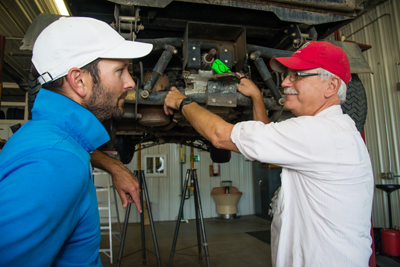
Ralph Arnt, veteran equipment manager at Hazeltine National,
is Tritabaugh’s shop whiz.
Photo by Kent Withington
Moy, who arrived at Hazeltine as an intern in 2007 and is now the top assistant, once thought he’d be a businessman. He previously worked in the fixed income department for Ameriprise Financial, sitting in a cubicle, which proved to be unfulfilling more days than not. When he couldn’t come up with a number in dollars and cents that would make him happy to stay in the job, Moy bolted for the outdoors and earned a master’s in horticulture with an emphasis on turfgrass management from the University of Minnesota. Nowadays, he is part of a world-famous event that’s priceless to him. “Hosting an event of this magnitude only brings our team closer together,” says Moy, who loves the frequent lunchtime brainstorming sessions where ideas for how to improve their efforts are welcomed and shared. Tritabaugh says, “I flat-out say to these guys, ‘If there’s a better way, tell me.’”
Giesen, 55, has been at Hazeltine National since it held the 1991 U.S. Open. Times have changed since then, and that has been a good thing for Giesen, who doesn’t work as many weekends as he did in his early years. “We’ve got a good core, and we have great camaraderie,” says Giesen, a golf course technician. “We think we keep the course in condition like they would have for a major event all the time.”
Then there is Arnt, the equipment manager who has been at Hazeltine National for 28 years. He’d considered retirement, but working for Tritabaugh has spurred him to stick around awhile longer. “This is a once-in-a-lifetime opportunity for pretty much all of us,” says Arnt, a two-year member of GCSAA.
On a mission
From the day it opened its doors in 1962, Hazeltine National was prepared for what is about to happen there. The first 22 words of its 300-word mission statement make that clear: The Mission of the founders of Hazeltine was to build and maintain a golf course suitable for the conduct of national championships.
“To be able to host an event that attracts so much interest across the world, it enhances the reputation of the club, gives us great pride and satisfaction, and it says your course has been up to the challenge,” Mackenzie says.
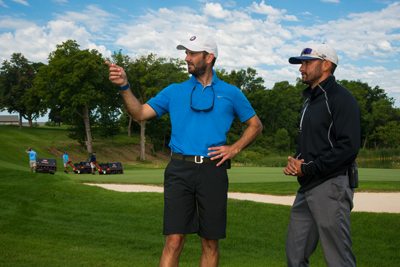
Top assistant Ryan Moy (right) has been at Tritabaugh’s side from the beginning, and he has been at Hazeltine even longer, having joined the maintenance crew as an intern in 2007.
Photo by Kent Withington
Hazeltine National (named for adjacent Lake Hazeltine) was ahead of its time in certain ways, Mackenzie says, and he credits Totton P. Heffelfinger, another former USGA president, as the driving force in making the club a reality. In 1959, Heffelfinger hired architect Robert Trent Jones Sr. to design the course. “We had women members at a time some clubs did not. We had Jewish members. When it came to golf, he (Heffelfinger) was all in,” Mackenzie says. “He was a pariah for some because he broke down barriers, but he always championed that golf is for everybody.”
It certainly attracted Tritabaugh to apply for the job he eventually landed there. “I find myself feeling very fortunate to be here, working with a board of governors who run the club in the right manner,” he says. Hazeltine National junior golf (which allows nonmember youths to participate) and the caddie program are accentuated, as is the Evans Scholarship program for caddies. “You’re introducing young people to the game,” Mackenzie says. “It’s contributing to the health and growth of the game. It’s just all good.”
Support for Hazeltine National also comes from outside its gates. An example is the Minnesota GCSA, which helps fund turf research at the University of Minnesota. Jack MacKenzie, CGCS, is the organization’s executive director. When he isn’t busy promoting golf in Minnesota (“We’re a $2.3 billion industry in the state, and $54 million is designated for charities,” he says), MacKenzie is championing Hazeltine National’s cause.
“They are the perfect example of environmental stewards — water reduction, naturalized turf areas. Chris and his crew have got the tools and an amazing membership. If you surround yourself with solids, your performance is going to be stellar,” MacKenzie says.
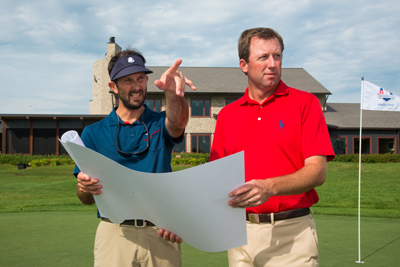
The club professional/superintendent tandem is solid at Hazeltine National. Club pro Chandler Withington (right) started at the course about the same time as Tritabaugh, and the two agree that supporting each other is essential to their success.
Photo by Kent Withington
Teamwork also factors into the superintendent/PGA club professional relationship. Tritabaugh and PGA club pro Chandler Withington were hired within one month of each other, and they have formed a bond that benefits both their work and, ultimately, the club. For example, if there is a course conditioning issue, Tritabaugh takes action to inform Withington before he hears it elsewhere. “He (Tritabaugh) gets out in front of it before the question is asked to me. As a golf pro, that is great for me, because it gives me the answers before they (members) ask the questions,” Withington says. “We have to support each other from a conditioning and accessibility standpoint. What I see in him is a great partner. It’s all I could ask for in a teammate.”
A September to remember
This will be a month Chris Tritabaugh will likely never forget. Besides turning 39 on Sept. 4, he and his wife, Lindsay (with whom he has daughters Olive and Penelope), will celebrate their 10th wedding anniversary on Sept. 29, which happens to be 24 hours before the Ryder Cup begins. “I told her, ‘Look at the party I’m throwing you!’ It is going to be quite a week,” Tritabaugh says.
When Tritabaugh gathers his staff and approximately 100 volunteers for their first meeting that week to launch the game plan, he won’t deliver a fiery, rah-rah pep talk. His words, however, will ooze team spirit for a major event that’s team-oriented to the max.
“The message will be the same as I tell my staff every day: We’re all great at what we do. Enjoy what you are going to be part of. Enjoy the company you are with. And enjoy the product that you are going to produce,” Tritabaugh says. “We will do this as a team — and it will be something special.”
Howard Richman is GCM’s associate editor.